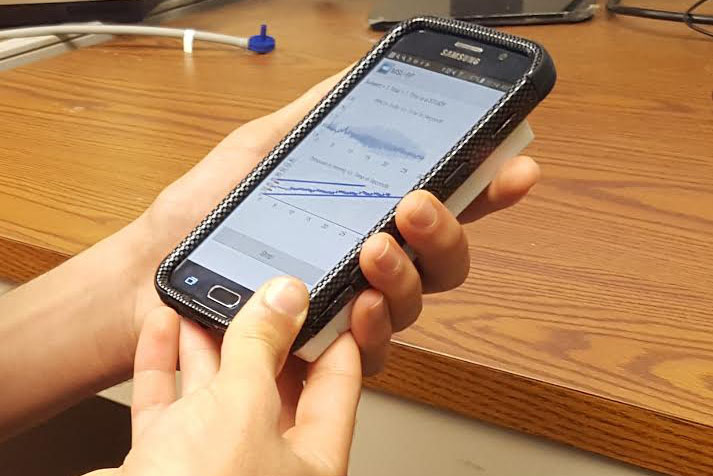A University of Maryland researcher helped create a prototype for a phone case and app that can detect a user’s blood pressure.
The device, created by mechanical engineering professor Jin-Oh Hahn, is meant to imitate what doctors currently use to measure blood pressure — a cuff device that wraps around a person’s arm that contracts and expands. The only difference with this technology is it can fit in your pocket, Hahn said.
The prototype works in a way that’s convenient to people, Hahn said. The phone case has sensors in the back that the user presses; the sensor sends the applied pressure to the app, which uses an algorithm to determine the individual’s blood pressure.
[Read more: An $8 million grant will help UMD researchers study hearing loss]
About 90 percent of users who tested the prototype learned how to use the device after one or two trials, according to a paper researchers published about it.
Hahn said he has worked on this research since 2014. Chang-Sei Kim, a researcher who formerly worked at this university, also worked on the project.
About 75 million American adults have high blood pressure, and almost half don’t have their condition under control, according to the Centers for Disease Control and Prevention. Many more don’t even know they have high blood pressure, Hahn said.
“We believe that one big reason some people don’t know or regulate blood pressure is because they can’t measure it frequently,” Hahn said. “With a device to measure blood pressure frequently, it will change everything.”
[Read more: The new CDC director is a UMD School of Medicine professor]
Anand Chandrasekhar, a researcher on the project, said it is important for people to check their pressure regularly.
“You don’t have access to a cuff all the time, but having a small device in your hand is convenient,” Chandrasekhar said. “What if your phone can do the same process?”
Roi Turalde, a senior family science major, said he would use the phone case and app if it was available to the public.
“It seems like a good way to help keep track of my health,” Turalde said. “Since I wouldn’t expect big changes in my blood pressure on a regular basis, I would probably use it two or three times a week, maybe more when I have midterms coming up.”
Hahn said the phone case is necessary because current smartphones don’t have an embedded pressure sensor.
“While this isn’t as convenient as having the sensor directly on the phone, when you buy a phone you buy a case anyway, right?” he said.
Before this technology is commercialized — which Hahn said will hopefully occur within five to 10 years — the project’s six researchers will talk to phone companies about possibly inserting a pressure sensor directly into the smartphone.
The product is still in the research phase, Hahn said, and team members are working on increasing the algorithm’s accuracy and reliability. During user testing, about 60 percent of the measurements were successful, according to the research paper.
“We are trying to learn a bit more and piece the gap between the technology and biomedical industries, which is important,” Chandrasekhar said. “It’s pretty exciting.”



